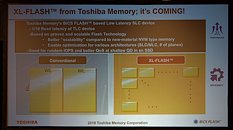Raevenlord
News Editor
- Joined
- Aug 12, 2016
- Messages
- 3,755 (1.18/day)
- Location
- Portugal
| System Name | The Ryzening |
|---|---|
| Processor | AMD Ryzen 9 5900X |
| Motherboard | MSI X570 MAG TOMAHAWK |
| Cooling | Lian Li Galahad 360mm AIO |
| Memory | 32 GB G.Skill Trident Z F4-3733 (4x 8 GB) |
| Video Card(s) | Gigabyte RTX 3070 Ti |
| Storage | Boot: Transcend MTE220S 2TB, Kintson A2000 1TB, Seagate Firewolf Pro 14 TB |
| Display(s) | Acer Nitro VG270UP (1440p 144 Hz IPS) |
| Case | Lian Li O11DX Dynamic White |
| Audio Device(s) | iFi Audio Zen DAC |
| Power Supply | Seasonic Focus+ 750 W |
| Mouse | Cooler Master Masterkeys Lite L |
| Keyboard | Cooler Master Masterkeys Lite L |
| Software | Windows 10 x64 |
Toshiba at the Flash Memory Summit announced that it's developing 3D XL-Flash technology - an approach towards the creation of low-latency, 3D NAND that can take on the surging Optane and 3D XPoint memory technologies. Toshiba says the new approach to low-latency NAND could bring latency values down to just 1/10 of current consumer, TLC NAND pricing.
The bet here is on economies of scale - a revised NAND architecture and deployment will still be able to take advantage of the huge fabrication capacity that Toshiba already enjoys (and Samsung, with its Z-NAND, similar in purpose to what Toshiba want to do with XL-Flash), thus avoiding the need for technology and production ramp-up that brought Optane's pricing up. Toshiba will be using its BiCS flash technology, but XL-Flash will be - at least at first - deployed in SLC implementations, so as to improve performance (7 microseconds program time against QLC's 30 microsecond). Of course, this will bring storage density down, but remember the target here is offering Optane-like performance and equal or better density at lower pricing.


The steps Toshiba has taken to increase performance include shortening bitlines and wordlines, internal connections between flash cells - shorter pathways means lower latency and improved performance. Additionally, parallelism and performance have been increased via the addition of more flash planes - independent regions that can respond to data requests simultaneously. Expect to see XL-Flash being used as caching memory in high-density QLC drives, as well as standalone products that look to dethrone Optane's grasp of peak theoretical performance.

View at TechPowerUp Main Site
The bet here is on economies of scale - a revised NAND architecture and deployment will still be able to take advantage of the huge fabrication capacity that Toshiba already enjoys (and Samsung, with its Z-NAND, similar in purpose to what Toshiba want to do with XL-Flash), thus avoiding the need for technology and production ramp-up that brought Optane's pricing up. Toshiba will be using its BiCS flash technology, but XL-Flash will be - at least at first - deployed in SLC implementations, so as to improve performance (7 microseconds program time against QLC's 30 microsecond). Of course, this will bring storage density down, but remember the target here is offering Optane-like performance and equal or better density at lower pricing.


The steps Toshiba has taken to increase performance include shortening bitlines and wordlines, internal connections between flash cells - shorter pathways means lower latency and improved performance. Additionally, parallelism and performance have been increased via the addition of more flash planes - independent regions that can respond to data requests simultaneously. Expect to see XL-Flash being used as caching memory in high-density QLC drives, as well as standalone products that look to dethrone Optane's grasp of peak theoretical performance.

View at TechPowerUp Main Site



